Content
- What are gallbladder symptoms
- How gallbladder symptoms manifest, diagnostic algorithm
- Vasilenko's symptom
- Kera's symptom
- Murphy's symptom
- Ortner's (Grekov) symptom
- Mussey-Georgievsky symptom (frenicus symptom)
- Riesman's symptom
- Boas symptom
- Lepen's symptom
- What does Kera and Murphy's positive symptom mean together?
- Similarities and differences of gallbladder symptoms
- What diseases of the gallbladder can be identified by checking the symptoms
- Gallbladder Symptoms Videos
Inflammation of the gallbladder occurs in people of all ages and genders. The diagnosis is made using various diagnostic methods, including using identifying a symptom of Kera and Murphand.
What are gallbladder symptoms
The gallbladder is an internal organ responsible for storing bile, which is produced by the liver. In a normal state, the gallbladder is soft and cannot be felt through the abdominal muscles. This organ becomes accessible for palpation with the development of inflammatory processes in it, because of which it increases in size and becomes more solid.
The main causes of gallbladder inflammation include:
- decreased tone of the walls of the organ;
- development of neoplasms - malignant and benign;
- purulent formations;
- formation of sand and stones.
Gallbladder symptoms are signs of inflammation in the gallbladder. In total, there are about 10 symptoms that indicate the appearance of cholecystitis. All of them are associated with an effect on the phrenic nerve, which provides nerve fibers to the gallbladder or peritoneum next to it.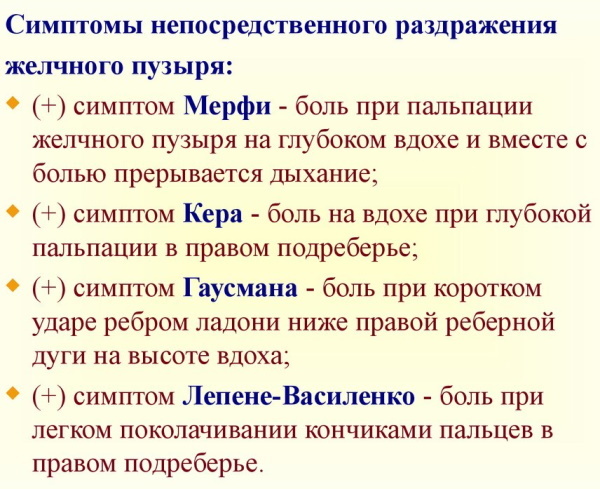
The main gallbladder symptoms include:
- Gubergrits-Pekarsky;
- Boas;
- Mussi-Georgievsky;
- Ortner-Grekov;
- Vasilenko;
- Obraztsova-Murphy;
- Kera.
The gallbladder symptoms have some peculiarities - their severity directly depends on the age of the patient. So, for example, in children under 3-5 years old, they may not appear at all.
How gallbladder symptoms manifest, diagnostic algorithm
Kera and Murphy's symptom is not the only diagnostic method for the development of inflammatory processes in the gallbladder. In total, there are more than 10 different symptoms that help determine the presence of problems in this organ.
Vasilenko's symptom
One of the most effective is the Vasilenko diagnostic symptom. It is manifested by pain with light tapping in the area of the gallbladder at the height of inspiration.
Vasilenko's symptom helps to diagnose inflammation of this organ at the initial stages of development.
Kera's symptom
This method of determining the pathologies of the gallbladder was discovered at the end of the 19th century by the German surgeon Hans Kerom, who had been studying gallstone disease for many years. He also identified a number of diagnostic methods, including palpation of the gallbladder. Subsequently, this symptom was named after this doctor.
If this symptom is found in a patient, it is required to immediately hospitalize him. Timely treatment significantly increases the patient's chances of a complete cure. Otherwise, organ rupture may occur and peritonitis may develop.
Kera's and Murphy's symptom are interrelated, since the area of exposure during palpation is the same, only the method of exposure differs. Kera's symptom is manifested by severe pain when pressed during palpation of the organ while inhaling with the thumb of the right hand.
Diagnostics is carried out according to the following algorithm:
- The thumb of the right hand is placed in the area of the gallbladder at the point of contact between the lower edge of the liver and the outer side of the rectus abdominis muscle.
- When inhaling, the skin is pushed down.
- Then, on exhalation, the finger is thoroughly immersed in the abdomen.
- An increase in pain in a person occurs during the next breath.
Kera's symptom helps to determine the development of cholecystitis or the presence of stones in the biliary tract or in the gallbladder. Moreover, during palpation in the first case, pain is given only to the organ itself, without spreading to nearby tissues. In the second case, Kera's symptom is accompanied by signs corresponding to the pathology.
Kera's symptom helps to make a diagnosis with almost 100% probability.
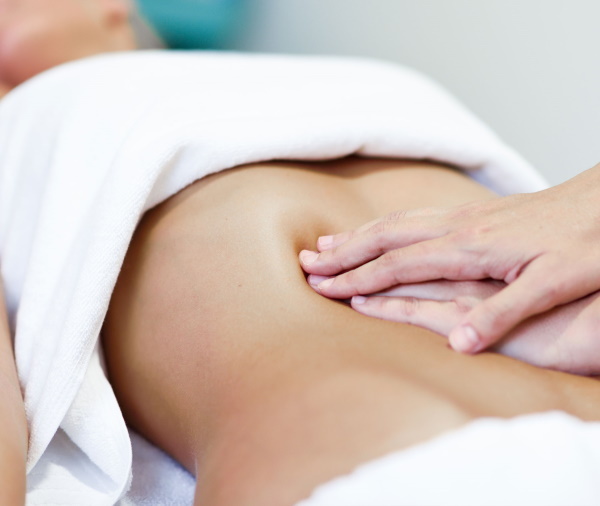 As additional diagnostic methods are used:
As additional diagnostic methods are used:
- X-ray of the gallbladder and biliary tract;
- Ultrasound of internal organs;
- laboratory blood diagnostics - general and biochemical.
It is important to remember that in inflammatory processes in the gallbladder, soreness with Kera's symptom manifests itself only in this organ. Concomitant signs such as vomiting, hyperthermia and irradiation of pain to other parts of the body indicate the development of diseases in other internal organs.
Murphy's symptom
Kera's and Murphy's symptoms were discovered at about the same time, in the 19th century. But the pattern of manifestation of the second was identified by the Chicago diagnostician and surgeon John B. Murphy. The method helps to quite accurately determine the acute phase of cholecystitis.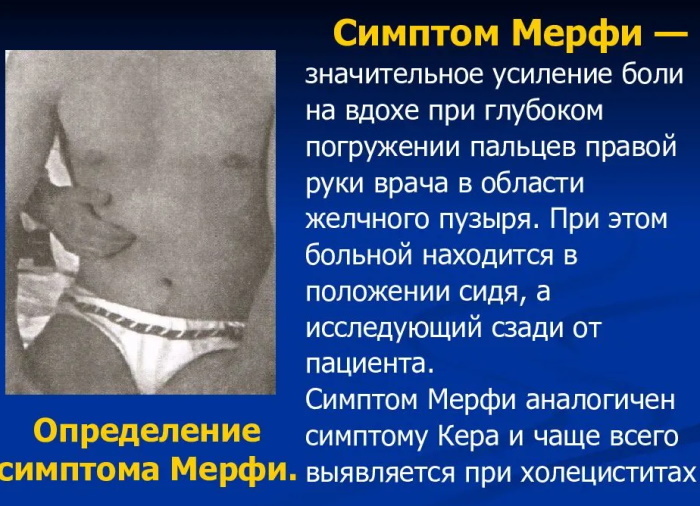
A survey is carried out in this way according to the following algorithm:
- The patient lies on his back.
- The doctor places the thumb of the left hand over the location of the gallbladder (the rest of the fingers are along the line of the ribs).
- The patient takes a deep breath, while the diagnostician applies pressure.
If the inhalation is interrupted, which indicates the occurrence of pain in the gallbladder, it means that inflammatory processes develop in it.
Murphy's symptom is successfully used for the primary diagnosis of acute cholecystitis and in modern medicine. With proper manipulation during palpation, this method helps to determine the development of the disease in almost 80% of cases.
Ortner's (Grekov) symptom
Kera's and Murphy's symptom are not the only diagnostic methods that allow quite accurately to identify the development of inflammatory processes in the gallbladder and biliary tract. Ortner's (Grekov's) symptom is considered no less effective.
It manifests itself in the diagnosis of acute and chronic cholecystitis. If, with a light tapping with the side of the palm on the lower right ribs, a dull pain appears, then with almost 100% probability, inflammatory processes develop in the organ. At the same time, in the chronic form of the disease, painful sensations are poorly expressed.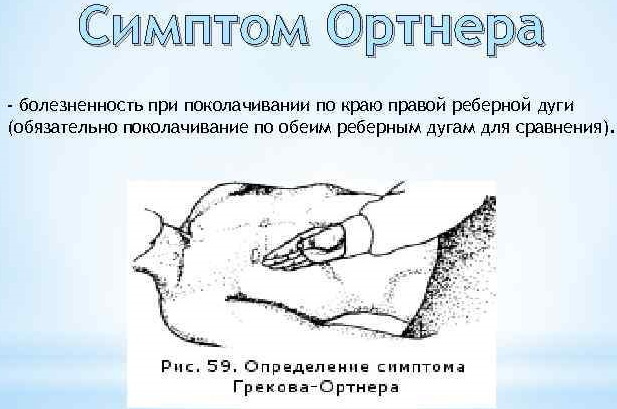
It is recommended to conduct an examination according to the Ortner (Grekov) method by tapping on the costal arches located on both sides. This ensures that the diagnosis is accurate. Despite the high efficiency of the method for making an accurate diagnosis, a number of additional examinations are necessarily prescribed.
These include:
- fibrogastroscopy;
- ECG;
- chest x-ray;
- Ultrasound of the liver, pancreas, gallbladder;
- detailed analyzes of urine and blood.
Ultrasound helps to determine not only the presence of inflammatory processes in the organ, but also a change in its size, thickening of the walls, the presence of stones.
Mussey-Georgievsky symptom (frenicus symptom)
The phrenicus sign helps to determine the presence of problems in the biliary tract. The patient experiences a sharp, sharp pain on palpation in the fossa of the sternocleidomastoid muscle.
Diagnosis is carried out for the symptom of Mussi-Georgievsky according to the following algorithm:
- The patient lies on his back.

- The doctor places the index finger between the clavicular and sternum processes of the sternocleidomastoid muscle.
- Presses lightly on the point on the right side.
If there are inflammatory processes in the biliary tract or in the gallbladder, then the patient during the manipulation will feel acute pain in the right hypochondrium.
To determine more complex pathologies with adjacent organs, palpation is duplicated on the left side.
The presence of acute pain in this case may indicate the following problems:
- profuse internal hemorrhages in the retroperitoneal region;
- purulent inflammation in the subphrenic space;
- violations of the integrity of the walls of the stomach with an ulcer;
- bruised or ruptured spleen.
The phrenicus sign is considered one of the simplest and most accurate palpation methods, as it helps even novice doctors to easily distinguish cholecystitis from other pathologies.
Riesman's symptom
Kera's and Murphy's symptom is similar in manifestations to Riesman's symptom.
Diagnostics is carried out using this palpation method according to the following algorithm:
- The patient lies on his back.
- Holds your breath while inhaling.
- The doctor at this time with the edge of the palm lightly taps in the area of the right hypochondrium.
If inflammatory processes develop in the gallbladder, then the patient during the manipulation experiences a sharp pain in the area of the organ.
Boas symptom
Pain points that help determine the development of gallstone disease, stomach ulcers or duodenal ulcers were discovered by the German physician I.I. Boas.
With this symptom, in case of inflammation of the gallbladder, pain occurs when the fingers press in the area of the free ends of the 11 and 12 ribs located on the right side (at Boas point).
Lepen's symptom
Lepen's symptom manifests itself if inflammatory processes are actively developing in the gallbladder. During the diagnosis, the doctor vigorously taps several times with bent fingers on the right costal arch at the height of inspiration.
What does Kera and Murphy's positive symptom mean together?
Kera's symptom is similar to Murphy's symptom, but differs in the detection technique. Collectively, they speak of acute cholecystitis, most often in uncomplicated forms.
This disease manifests itself:
- paroxysmal pain in the right hypochondrium (most often after eating);
- muscle tension in this area;
- vomiting;
- pain when performing palpation.
In addition to Kera's and Murphy's symptoms, the Grekov-Ortner symptom often indicates the development of acute uncomplicated cholecystitis.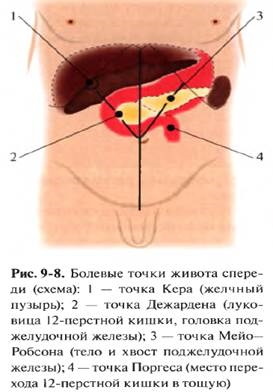
With their help, it is possible to preliminarily diagnose acute cholecystitis in complicated forms.
Often this pathology is accompanied by:
- inflammation of the bile ducts;
- obstructive jaundice;
- signs of intoxication (increase in the level of leukocytes in the blood, heart palpitations, fever).
In some cases, diagnosis using Kera's and Murphy's symptoms is not effective.
These include:
- severe concomitant pathologies;
- mental disorder in a patient;
- old age;
- features of the anatomical structure (for example, the gallbladder is covered by adjacent tissues).
In this case, use other diagnostic techniques - laboratory and instrumental.
Similarities and differences of gallbladder symptoms
All gallbladder symptoms, one way or another, speak of various diseases of the gallbladder. They all have both similarities and differences. Soreness manifests itself with various manipulations.
| Name | Similarities | Differences |
| Vasilenko | On inspiration when tapping on the right hypochondrium | |
| Kera | Inhaling with finger pressure | |
| Murphy | Inhaling with finger pressure | |
| Ortner-Grekov | When tapping on the edge of the right rib (carried out symmetrically on both sides). | |
| Mussi-Georgievsky | With pressure between the legs of the sternocleidomastoid muscle irradiating to the area of the gallbladder. | |
| Riesman | When tapping on the rib while holding the breath. | |
| Boasa | Increased sensitivity on the right side of the lumbar region. Pain on the same side in the area of the location of the transverse processes of ThXI-LI. | |
| Lepena | When tapping with a bent finger in the area of the gallbladder. |
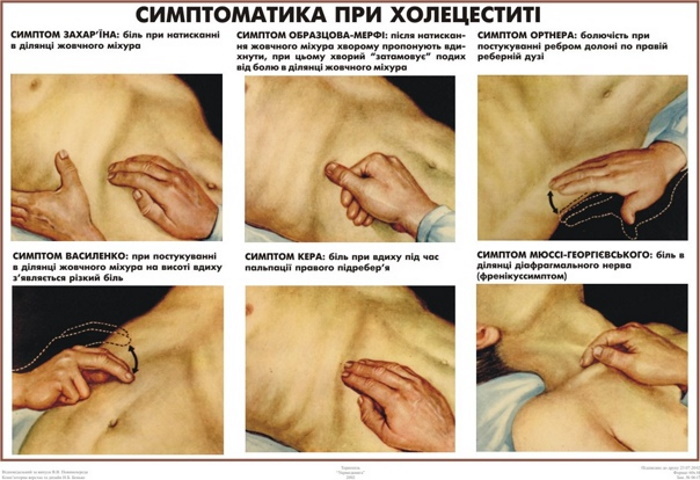
In some cases, several types of palpation are used for diagnosis at once, especially if due to anatomical structural features of the patient's body, it is not possible to palpate the gallbladder to detect Kera's symptoms or Murphy.
What diseases of the gallbladder can be identified by checking the symptoms
Bubble symptoms help with almost 100% probability to identify various diseases of the gallbladder, both in acute and chronic forms. Dysfunction of the sphincter of Oddi is often accompanied by other diseases of the digestive tract.
Such as:
- impaired motility of the small and / or large intestine;
- inflammation of the stomach lining;
- hernia of the esophageal opening of the diaphragm;
- stomach and duodenal ulcers;
- chronic pancreatitis.
The disease manifests itself with paroxysmal pain in the region of the stomach (often the duration of the attack reaches 30 minutes). At the same time, ultrasound does not reveal any abnormalities in the gallbladder, pancreas and liver. And when gallbladder symptoms are detected, pain under the ribs on the right side is characteristic.
The lack of timely treatment for the dysfunction of the sphincter of Oddi can provoke the development of diseases of the gallbladder - stone formation, cholecystitis and cholangitis.
The chronic form of cholecystitis is a disease of the gallbladder, in most cases it is diagnosed in women. The acute form of pathology occurs only if the diet is not followed.
In addition to gallbladder symptoms, the following signs indicate this disease:
- dull pains with irradiation under the scapula, into the region of the heart, subclavian region, neck and back (when moving, they become more intense), often occurring at night, especially after a violation of the diet (often accompanied by deep breathing and cough);
- lack of appetite;
- quite pronounced intoxication and inflammatory syndromes;
- painful or difficult digestion;
- nausea and vomiting;
- sometimes yellowness of the skin (more often with cholangitis);
- an increase in body temperature up to 38 ° C;
- feeling of heaviness in the right hypochondrium;
- bitterness in the mouth;
- belching.
Chronic cholecystitis often occurs with regular intervals between exacerbation and remission. In some cases, this disease can lead to the formation of stones in the gallbladder.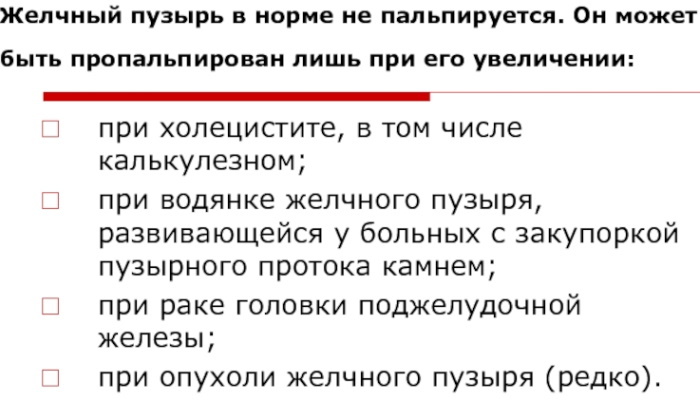
If you follow the treatment and nutrition regimen prescribed by your doctor, then attacks of cholecystitis may not bother you for a long time.
Gallstone disease is also more likely to affect women over 35 years old, especially those with a tendency to be overweight.
In addition to positive gallbladder symptoms, this disease is characterized by the following symptoms:
- jaundice, which appears within 24 hours after the end of the attack and gradually begins to disappear after about 3 days from the attack;
- intolerance to fatty foods, manifested by mild abdominal pain, flatulence and diarrhea;
- paroxysmal pain in the right hypochondrium, which can last for several hours and stop as suddenly as it began (while in a sitting position, the pain increases significantly;
- signs of intoxication;
- a wave-like increase in body temperature up to 38 ° C, often allowing to suspect a parallel acute cholecystitis.
Also, gallstone disease can be accompanied by atypical symptoms - nausea, vomiting, and stool disorders.
In this disease, seizures are most often provoked by non-compliance with the diet prescribed by the attending physician. In some cases, gallstone disease can lead to rupture of the walls of the organ or the accumulation of pus in its cavity.
For any disease of the gallbladder, not only examination and palpation, but also laboratory research methods are used to make an accurate diagnosis.
All gallbladder symptoms indicate various diseases of the gallbladder and its ducts, while the effectiveness of each of them is different. Only the symptoms of Kera and Murphy are almost 100% likely to indicate the development of cholecystitis.
Gallbladder Symptoms Videos
Symptoms of gallbladder damage:
